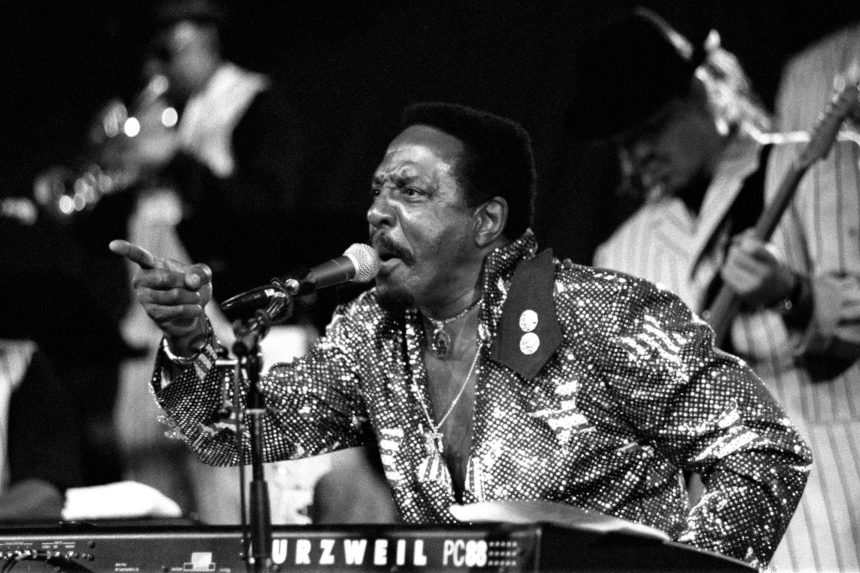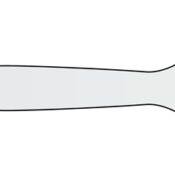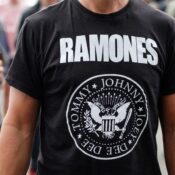Firsts can be a funny thing. Some firsts are pretty hard to dispute, like first U.S. president, first man on the Moon, or the birth of your first child (even if younger siblings think they came first). Other firsts are more nebulous, and require debate and conversation. That’s particularly true in the world of music, especially when it comes to the birth of a whole new form or genre. When we consider the advent of rock and roll, there are any number of candidates for the first rock song. In fact, it might be an unanswerable question. However, there is one song that comes closest to being the answer, and it was recorded 70 years ago this week.
Unlike your first child, it’s harder to nail down when rock and roll was actually born. Most musicologists will assert that rock exists at the intersection of previously established genres like the blues, gospel, country, folk, and jazz. Rock’s direct antecedent is rhythm and blues, which, in the 1940s, was a faster, more beat-driven blues styling. That’s where some of the confusion comes in, because a number of records made in the 1940s sound like proper early rock, but were identified and marketed as other forms, like blues. Examples include Sister Rosetta Tharpe’s “Strange Things Happening Every Day” from 1944, “Good Rocking Tonight” from 1947 and “Rockin’ at Midnight” from 1948 (both by Roy Brown), Wild Bill Moore’s “Rock and Roll” from 1948, and even 1952’s “Hound Dog” by Big Mama Thornton (yeah, Elvis’s was a cover). You might look at the use of “rock” in three of those titles and think, game over, but many writers and scholars say that despite the word (both a reference to the gospel “rocking” prevalent in the Black church and southern slang for, uh, other activities), the elements that make a rock record, well, rock, aren’t entirely there.
“That’s All Right” (Uploaded to YouTube by Elvis Presley)
What’s fairly certain is that songs often cited as first rock songs, like “Rock Around the Clock” by Bill Haley and His Comets, aren’t the answer. 1954’s “Clock” wasn’t even Haley’s first rock song to chart, and it still came along a couple of months after “Shake, Rattle, and Roll” by Big Joe Turner. Likewise, Elvis Presley’s “That’s All Right” was a cover of a 1940s tune and charted after both Haley and Turner; ironically, his second single was a cover of Roy Brown’s “Good Rocking Tonight.” Chuck Berry’s first single, “Maybellene,” hit in 1955, as did Fats Domino’s “Ain’t That a Shame” and Little Richard’s “Tutti Frutti.” Several of these artists, like Domino and Little Richard, had already released multiple singles before their sound was considered to have transitioned from blues or old-school rhythm and blues to “rock and roll.” Part of that transition was a new phenomenon: white acceptance.
An inextricable part of the confusion over the first rock tune is simply that, in the 1950s, the artistic and musical contributions of Black Americans were simply dismissed. Trying to attribute the birth of rock as something that happened in 1954 and emerged fully formed under Haley and Elvis is laughable, but it’s a cultural idea that persisted for years and was pushed by, well, marketers trying to sell records to white kids. The truth is that those musical forces brewing from various cultural and geographical influences had coalesced into a new form of blues, one that would be captured on record in the first week of March of 1951. The song is attributed to Jackie Brenston and his Delta Cats on the record’s label, but the actual band was Ike Turner and the Kings of Rhythm. The song was “Rocket 88.”
“Rocket 88” (Uploaded to YouTube by Jackie Brenston)
There is some stable ground in asserting that “Rocket 88” was most likely the first rock and roll song. After all, the Rock and Roll Hall of Fame and The New Rolling Stone Encyclopedia of Rock and Roll allow that this is probably the case. If it is the first, it’s because the recording puts together a lot of familiar, distinct rock elements. One of those was the producer: Sam Phillips.
The founder of Memphis’s Sun Studio and the hugely influential Sun Records, Sam Phillips produced and recorded the likes of Elvis, Jerry Lee Lewis, Roy Orbison, Howlin’ Wolf, Carl Perkins, B.B. King, Junior Parker, and Johnny Cash. Philips was the rare figure who promoted racial equality in music; he also founded radio station WHER in 1955, which was almost entirely run by women and played only female artists.
Turner and the Kings of Rhythm went to Phillips to record their single. “Rocket 88” was about the Oldsmobile Rocket 88, which was a new set of wheels at the time. Cars would go on to be a recurring image in rock, inspiring everything from “Little Deuce Coupe” to “Low Rider” to “Mercedes Benz.” The style of the song was pulled from a couple of earlier influences: blues tunes “Cadillac Boogie” and “Rocket 88 Boogie” (Parts 1 and 2), which were a pair of instrumentals. The group shot for a rougher swing on the sound. On vocals was Jackie Brenston, who usually played sax in Turner’s band. Turner played piano on the tune (the intro of which Little Richard would later admit that he lifted for “Good Golly, Miss Molly”). Since Brenston was singing, Raymond Hill played tenor sax.
The piano/sax/drums arrangement wouldn’t have been off-brand for blues at the time, and neither would the electric guitar. However, an accident on the way to record changed the very sound of that instrument. Whether it was dropped or fell out of the car while searching for a spare tire (as one version goes), the amp belonging to guitarist Willie Kizart suffered from a broken cone. The band shoved newspapers into the amp to try keep everything in place. The amp worked, but it had a different sound; we call it distortion.
Whatever alchemy comes from playing together in a band was in full effect, as “Rocket 88” managed to take the stuff that had come before it, but still sound new. Increased tempo, subject matter, that distorted guitar sound . . . these things inform what makes that record, well, rock. Licensed to Chess Records, who switched the band’s name on the label, the song went to #1 on the Billboard R&B records chart that June and was the most-played jukebox song in June and July.
Ike & Tina Turner Revue, “Proud Mary” on The Ed Sullivan Show in 1970 (Uploaded to YouTube by The Ed Sullivan Show)
Ultimately, the best we can do is decide that “Rocket 88” is probably the original rock record. Turner certainly went on to have an influence on the genre as a session player and songwriter; from 1962 to 1978, he was married to Tina Turner. Their group, the Ike & Tina Turner Revue, landed them in the Rock and Roll Hall of Fame. Ike Turner is widely acclaimed for his role in establishing the genre, and won many awards in his career; however, his legendary temper; personal, drug, and legal problems; and his known abuse of women (including Tina) have diminished his esteem in retrospect. It’s possible that all of those issues have had an impact on the assessment of the importance of “Rocket 88.” At the end of the day, the question may never be answered; but, of course, as some London cats once sang, it’s only rock and roll.
Featured image: Ike Turner (Sergei Bachlakov / Shutterstock)
Become a Saturday Evening Post member and enjoy unlimited access. Subscribe now




Comments
Rocket 88 is the first rock and roll song? You gotta be kidding! It is barely listenable. Are we being PC here?
I always thought rock and roll was defined by the back beat, i.e., 4/4 time or 4 notes to maeasure with the strongest beat on the 3rd note.
I think that should be the first comsideration when looking for “elements” of rock and roll.
Like so many things. Nothing exists until a white person sees something and duplicates it. Then he will say he invented it.
I always thought Bill Hayleys Rock Around the Clock was the first big rock and roll song.
I think someone got their electrical equipment mixed up. If you stuffed a newspaper in an amp back then, it would have started a fire. Amps used vacuum tubes which would get hot enough to ignite a paper.
Most likely, they meant the paper was stuffed into the loudspeaker. The rough, scratchy result would have sounded a lot like distortion. Many speaker cones were made of a stiff form of paper but adding more of it would have changed the output.
Elvis may not have created it which he admitted. But he sold it better than anyone else. He gave a whole young generation around the world their music.
Elvis’s “Hound Dog” was a fairly early entry, but it was Elvis’s fourth #1 of 1956. “Rock Around the Clock” topped the sales charts for 8 straight weeks in 1955. Other tunes, like Little Richard’s “Tutti Frutti,” preceded “Hound Dog” on the pop chart.
As for “Clock,” I say “sales charts” because there will still separate lists until November of 1955: best sellers in stores, most played by DJs, and most played on juke boxes. That November, Billboard created the unified Top 100 list. For historical purposes, Billboard considers sales as the best metric prior to the Top 100’s introduction. By 1958, they had created the cross-genre Hot 100, which is still the measuring standard.
The original version of Hound Dog that Elvis stole from Big Mama Thornton’s 1953 hit has to be a contender for first popular rock’n’roll song.
I have to agree on ‘Rocket 88’ for the reasons you state as probably the original rock record as well. It’s not an easy thing to definitively determine, as the 1947 and ’48 links illustrate. ‘Good Rocking Tonight’ and ‘Rockin’ at Midnight’ are wonderful forerunners. (Robert Plant’s mid-80’s version of the latter was amazing, and true to the original.)
Rock had strong ties to the jazz that preceded it, and a crossover of many of its elements in the early years discussed here. The guitar/electric guitar probably more than any single differentiating factor at first, helped ‘rock’ become a fully separate genre and entity between the late ’40s and mid ’50s.
I’m sure because the pioneering ‘rockers’ were black, their works were unfairly dismissed for that reason. Rock did not suddenly ‘materialize’ in 1954 with white musicians. The upside there is that it opened the way for black artists like Chuck Berry, Little Richard and so many more to flourish from that point on. They were very popular with white audiences for concerts and record sales.
It was around 1956 (to 1963) that Doo-Wop started, which was an off-shoot of rock; some more than others depending on the the particular song, of course. Thanks for all the links, including ‘Proud Mary’ from The Ed Sullivan Show. The more times change the more enjoyable his shows get. I wish they could have lasted until about ’85 though. 1971 was too soon for it to end!